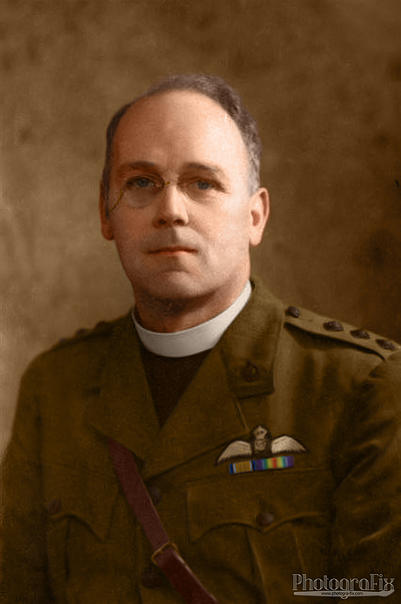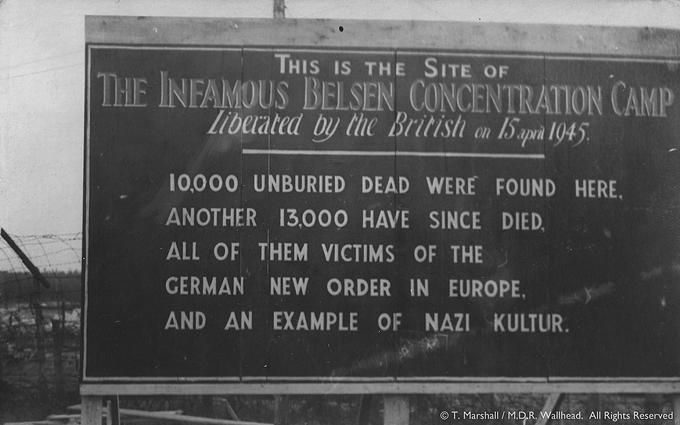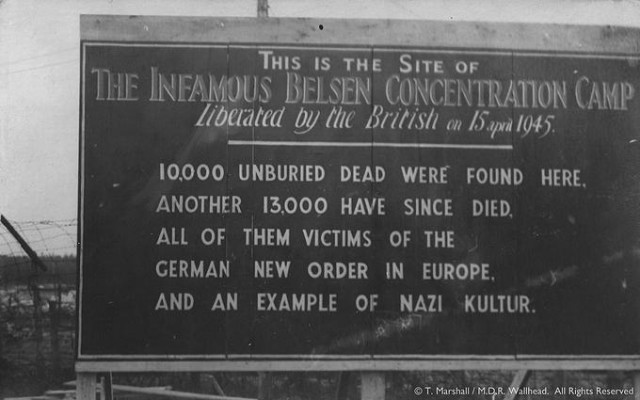The images contained in this article may be shocking, but are included to highlight a very dark period of human history. Today it’s exactly 70 years ago that Bergen Belsen Concentration camp was liberated, to commemorate this Tom Marshall shares his article with us.
In my line of work as a photo restorer and colouriser of historical photos, I often come across very interesting stories that impel me to dig deeper and find out as much as I can about the people in the pictures, and what they did with their lives.
This article is a bit different to my usual work, as it’s a story that’s very personal to my family and it’s something I feel I need to share now, particularly as this month marks 70 years since these events occurred.

My Great Grandfather, The Reverend Charles Martin King Parsons CF was an army chaplain with the 9th British General Hospital during WW2. This is a photo I have colourised of him in his chaplain uniform. The wings on his chest are a reminder that he had already served his country in the 1914-18 war in the Royal Flying Corps.
During the interbellum, following his father before him, he entered the church and when WW2 broke out he joined the home guard. In November 1943, aged 44 he was given a chaplaincy in the Royal Army Chaplain’s Department.
On April 15th 1945 British and Canadian forces liberated Bergen-Belsen, the Nazi concentration camp which was described by Major Dick Williams, one of the first British soldiers to enter as;
“an evil, filthy place; a hell on Earth.”
CMK Parsons was one of a handful of British Army chaplains who entered the camp in the days following liberation.
I recently visited my Grandmother, Ruth (Charles’ daughter) and discovered the following photographs taken by her father when he was at Belsen. The following photos have never been published or seen publically before. Due to the subject matter some of the photos he took are very shocking.
Bergen-Belsen was originally established as a prisoner of war camp and later an ‘exchange camp’ for Jewish hostages, with the intention being that they would be exchanged for German POWs held overseas. During the course of the war, it became a concentration camp and the final resting place for over 50,000 Jews, Poles, Soviets, anti-Nazi Christians, homosexuals, and Roma and Sinti (Gypsies), many of whom were transferred there from other camps throughout Germany. Perhaps the most discussed Jewish victim of the Holocaust Anne Frank died in Belsen shortly before the liberation, probably of typhus which was rife among the dying.
When Charles arrived at the camp there were nearly 500 people dying each day, from the appalling conditions and the typhus outbreak. Along with the other chaplains, medical staff and medical volunteers, he saved many lives and gave both spiritual and medical support to the survivors.
One of the most useful roles the chaplains undertook was to try and contact the families of former prisoners in the world outside the horrors of the camp and to provide spiritual care, despite the majority of the victims being of a different faith to most of the chaplains themselves.
A colleague of Charles, Rev. Leslie Hardman MBE HCF was the first Jewish British Army Chaplain to enter the camp. He later wrote;
“Towards me came what seemed to be the remnants of a holocaust – a staggering mass of blackened skin and bones, held together somehow with filthy rags. ‘My God, the dead walk’, I cried aloud, but I did not recognise my voice… (peering) at the double star, the emblem of Jewry on my tunice – one poor creature touched and then stroked the badge of my faith, and finding that it was real murmured, ‘Rabbiner, Rabbiner’.”
Like many people affected by the horrors they saw during the war, CMK Parsons never really spoke about his experiences at Bergen-Belsen to his wife or daughters Ruth and Joan. The information I’ve been able to find out has been based on letters written to him after the war from colleagues and my own research into the events of April and May 1945.
In Ruth’s possession is the ink stand from the office of the Commandant of Bergen-Belsen, Josef Kramer.
Kramer was dubbed ‘The Beast of Belsen’ by inmates of the camp and hanged some months later by British executioner Albert Pierrepoint.
We understand that Charles took the ink stand as a keepsake shortly before the buildings were raised to the ground. It is chilling to think just how many death notices were written with that stand. The ink stand spent many years in a very different building after the war, in Charles’ vestry at Breedon Church, Leicestershire where he was the Vicar until his death in 1953.
Joan’s memento doesn’t have the historical significance that the ink stand does, but the story behind it is just as, if not more, moving. This tiny intricate painting was given to Charles as a thank you from a female inmate of the camp hospital. It is a simple painting on a black medical container lid marked ‘Belsen Camp, May-June ’45, showing pictures of medical implements.
Whilst researching Belsen, I also learnt that there is a connection to my Father’s side of the family too, as his Father, John Marshall drove one of the tanks that first liberated the camp. I wouldn’t be surprised if he and my Mother’s Grandfather hadn’t met at some point in those months.
Discovering what CMK Parsons went through at Belsen has been a very interesting and humbling experience. I never knew him as he died 35 years before I was born but I do know he was a brave man who saved many lives. I have also come to learn how important the non military members of the forces were, and still are, providing essential support and care at times of need. I’m very proud of my Great Grandfather and I know that you don’t have to be a soldier to fight a war.
Special thanks to Ruth and Joan for their help and permission to write this article.
Written by Tom Marshall
You can see more of his amazing work on his website: www.photogra-fix.com
And his Facebook page: www.facebook.com/PhotograFixUK
Reproduced with permission on War History Online

